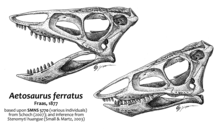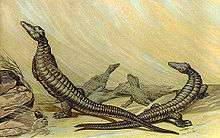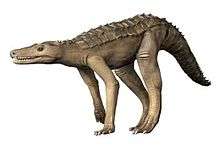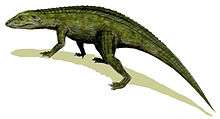Aetosaurus
Aetosaurus is an extinct genus of archosaur reptile belonging to the order Aetosauria. It is generally considered to be the most primitive aetosaur.[1] Three species are currently recognized: A. ferratus, the type species from Germany and Italy;[2] A. crassicauda from Germany;[3] and A. arcuatus from eastern North America.[4] Additional specimens referred to Aetosaurus have been found in the Chinle Group of the southwestern United States,[5][6] and the Fleming Fjord Formation of Greenland.[7] Specimens of Aetosaurus occur in Norian-age strata.
| Aetosaurus Temporal range: Late Triassic | |
|---|---|
| Assemblage of fossil A. ferratus | |
| Scientific classification | |
| Kingdom: | Animalia |
| Phylum: | Chordata |
| Class: | Reptilia |
| Order: | †Aetosauria |
| Family: | †Stagonolepididae |
| Subfamily: | †Aetosaurinae |
| Genus: | †Aetosaurus Fraas, 1887 |
| Species | |
| |
| Synonyms | |
| |
Description
Aetosaurus was a small, primitive aetosaur. Unlike more derived aetosaurs such as Desmatosuchus or Typothorax, the carapace was long and narrow and lacked spikes. The paramedian scutes that covered the back (with one row on each side of the vertebrae) are considerably wider than they are long. The lateral scutes, which are beneath the paramedians and formed a row on either side of the animal, do not bear any spikes or other projections.[4]
Species

Aetosaurus was first named, with the description of the type species A. ferratus, in 1877 by German paleontologist Oscar Fraas. At the time, Aetosaurus was known from 22 articulated skeletons that had been found in the Lower Stubensandtein of Germany.[2] Thirty years later, Fraas' son Eberhard described a second species, A. crassicauda, also from Germany.[3] A. crassicauda can be distinguished from A. ferratus by its larger size; A. crassicauda reached a maximum length of 150 centimetres (59 in) while A. ferratus reached a length of up to 90 centimetres (35 in).[1]
In addition to the Stubensandtein in Germany, A. ferratus is also known from the Calcare di Zorzino Formation in Cene, Italy.[8] Specimens of Aetosaurus that have been recovered from the Fleming Fjord Formation in Greenland likely represent A. ferratus.[7] Some material from the Chinle Group in the southwestern United States probably represent A. ferratus, as well.[5][6]
In 1998, the genus Stegomus was synonymized with Aetosaurus.[4] In 1896, paleontologist Othniel Charles Marsh named Stegomus arcuatus from a cast of an aetosaur known as YPM 1647 from the New Haven Formation in Fairfield, Connecticut.[9] This cast consisted of the dorsal carapace. Several other casts preserving the surface of the skull and tail have been found in the Passaic Formation of Hunterdon and Somerset counties, New Jersey[10][11] and an outcrop of the Lower Sanford Formation at the Triangle Brick Co. Quarry in Durham County, North Carolina.[12] Stegomus arcuatus was found to be synonymous with Aetosaurus on the basis of several similarities, including a lack of spikes and a distinctive radial pattern of grooves on some of the caudal scutes.[4]

A. arcuatus has paramedian scutes that are much wider than they are long, even in comparison to other species of Aetosaurus. There is very little pitting on the surface of the scutes, although the porosity of the sandstone that makes up the casts has been mistaken for pitting.[13] The tail narrows significantly past the base. The carapace is "waisted", meaning that it narrows in front of the pelvis.[4]
The following cladogram simplified after an analysis presented by Julia B. Desojo, Martin D. Ezcurra and Edio E. Kischlat (2012).[14]
| Aetosauria |
| ||||||||||||||||||||||||||||||||||||||||||||||||||||||||||||||||||||||||||||||||||||||||||||||||
References
- Heckert, A.B.; Lucas, S.G. (1999). "A new aetosaur (Reptilia: Archosauria) from the Upper Triassic of Texas and the phylogeny of aetosaurs". Journal of Vertebrate Paleontology. 19 (1): 50–68. CiteSeerX 10.1.1.563.9516. doi:10.1080/02724634.1999.10011122.
- Fraas, O. (1877). "Aetosaurus ferratus Fr. Die gepanzerte Vogel-Echse aus dem Stubensandstein bei Stuttgar". Festschrift zur Feier des 400jährigen Jubiläums der Eberhard-Karls-Universät zu Tübingen, Wurttembergische Naturwissenschaftliche Jahreshefte. 33 (3): 1–22.
- Fraas, E. (1907). "Aëtosaurus crassicauda n. sp., nebst Beobachtungen tiber das Becken der Aëtosaurier". Jahreshefte des Vereins für Vaterländische Naturkunde Württemberg. 42: 101–109.
- Lucas, S.G.; Heckert, A.B.; Huber, P. (1998). "Aetosaurus (Archosauromorpha) from the Upper Triassic of the Newark Supergroup, eastern United States, and its biochronological significance" (PDF). Palaeontology. 41 (6): 1215–1230. Archived from the original (PDF) on 2012-03-09.
- Heckert, A.B.; Lucas, S.G. (1998). "First occurrence of Aetosaurus (Reptilia: Archosauria) in the Upper Triassic Chinle Group (USA) and its biochronological significance". Neues Jahrbuch für Geologie und Paläontologie. 1998: 604–612.
- Small, B.J. (1998). "The occurrence of Aetosaurus in the Chinle Formation (Late Triassic, USA) and its biostratigraphic significance". Neues Jahrbuch für Geologie und Paläontologie. 1998 (3): 289–300.
- Jenkins, F.A. Jr.; Shubin, N.H.; Amaral, W.W.; Gatesy, S.M.; Schaff, C.R.; Clemmensen, L.B.; Downs, W.R.; Davidson, A.R.; Bonde, N.; Osbaeck, F.F. (1994). "Late Triassic continental vertebrates and depositional environments of the Fleming Fjord Formation, Jameson Land, East Greenland". Meddelelser om Grønland, Geoscience. 32: 1–25.
- Wild, R. (1989). "Aëtosaurus (Reptilia:Thecodontia) from the Upper Triassic (Norian) of Cene near Bergamo, Italy, with a revision of the genus" (PDF). Revista del Museo Civico di Scienze Naturali "Enrico Caffi". 14: 1–24.
- Marsh, O.C. (1896). "A new belodont reptile (Stegomus) from the Connecticut River Sandstone" (PDF). American Journal of Science. 2 (7): 59–62. doi:10.2475/ajs.s4-2.7.59.
- Jepsen, G.L. (1948). "A Triassic armored reptile from New Jersey". State of New Jersey Department of Conservation Miscellaneous Geological Paper: 1–20.
- Baird, D. (1986). "Some Upper Triassic reptiles, footprints and an amphibian from New Jersey". The Mosasaur. 3: 125–135.
- Parker, J.M. (1966). "Triassic reptilian fossil from Wake County, North Carolina". Journal of the Elisha Mitchell Society. 82: 92.
- Lull, R.S. (1953). "Triassic life of the Connecticut Valley revised". Bulletin of the Connecticut Geologic and Natural History Survey. 81: 1–336.
- Julia B. Desojo, Martin D. Ezcurra and Edio E. Kischlat (2012). "A new aetosaur genus (Archosauria: Pseudosuchia) from the early Late Triassic of southern Brazil" (PDF). Zootaxa. 3166: 1–33. doi:10.11646/zootaxa.3166.1.1. ISSN 1175-5334.
External links
- Aetosaurus in the Paleobiology Database


